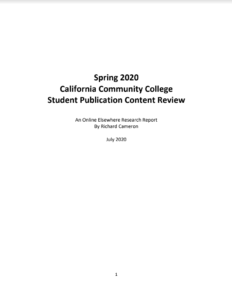Community College student newspapers illustrate publishing trends
By Richard Cameron
Cerritos College
What types of stories do community college student newspapers publish on their online sites in a typical semester/quarter? That was the original purposed of a content review of 46 California community college student publications conducted for the spring 2020 term.
“It is a capital mistake to theorize before one has data.” Sherlock Holmes, “A Study in Scarlett” (Arthur Conan Doyle)
Of course, the spring 2020 term turned out to be anything but typical as COVID-19 caused a mid-term shutdown of campuses and a shift to remote instruction. While not intended, the bifurcated study was fortuitous in timing, however, as it appears all campuses will start a new academic year with remote instruction, indeed the whole academic year may be remote.
 Slightly less than 40% of California’s 119 community colleges offer associate degrees in journalism, and an important component in those degrees requires course work on the student publication. Forty-six have online publications. The colleges offer multiple levels of enrollment in publication courses, from beginning to advanced, and nearly all combine up to four levels of courses into one newspaper staff, so the mix of experience on a given staff varies greatly from campus to campus.
Slightly less than 40% of California’s 119 community colleges offer associate degrees in journalism, and an important component in those degrees requires course work on the student publication. Forty-six have online publications. The colleges offer multiple levels of enrollment in publication courses, from beginning to advanced, and nearly all combine up to four levels of courses into one newspaper staff, so the mix of experience on a given staff varies greatly from campus to campus.
The colleges’ student publication sites’ RSS feeds were monitored from Jan. 1 to June 15 and each of the 5,631 stories published were categorized by story type and story focus.
Story types were news, editorial/opinion column (opinion), sports, feature/opinion feature (feature), and other. Nearly all stories were text based, so others included photo stories, podcast, video, infographs, etc.
“Merely measuring something has an uncanny tendency to improve it.” Paul Graham, co-founder at Y Combinator
Story focus included campus, community, and general (non-campus/non-community). Most publications put a heavy focus on campus news, while others favored community or general news. Nearly 57% of all content was campus focused, 26.7% was general focused — due largely to national- or cultural-based features and opinion features — and 15.5% was community focused.
Less than half of all content was news based, but that was the dominant form. Nearly 19% was feature/opinion feature based, and 16 percent was opinion stories. Sports accounted for 12.4%, but, predictably, most of that was before the pandemic hit and sports schedules were suspended.
Three stories particularly captured the attention of nearly all publications during the term.
- The death of retired professional basketball player Kobe Bryant in February;
- The COVID-19 virus and its impact to campuses, community, and nation; and
- Local and national protests on race relations resulting from the death of African American Minnesotan George Floyd while in police custody and the national/international protests and violence that followed.
The study also looked at days of the week publications posted stories. Not measured by the study directly, but observed, was that many publications still follow a print deadline mindset and large blocks of stories would be posted once a week, once every, other week, once every third week, etc. around the release of their print editions. This, of course changed for many colleges once print publications ceased because campuses were closed. About one-third of the colleges continued posting PDF versions of a print-style publication, however.
Nearly a quarter of all stories were published on Wednesdays and the rest were fairly scattered throughout the week. Thursday and weekend postings saw an increase, as a percentage, after the campus closures.
While statewide leaders in various categories were identified, this was not an attempt to identify winners and losers, but rather to emphasize possibilities and provide a basis for self-comparison. Included in the study were college-by-college charts of their own data, with the hope that they would use the information to establish strategic goals.
Based on the nature of the production courses being integral to the education processes, the weekly percentage of stories produced each week dropped after the campuses closed. Many inequities faced the campuses: some schools had started terms earlier than others and had more time to develop cohesive staffs, some instructors were better prepared than others to shift to an online atmosphere, and many students did not have access to computers and/or reliable internet. While most publications did see a drop in weekly production, that was not true for all. One college, for instance, managed to double its output. Overall, there was a 14% weekly average increase because of these publications. Others saw as much as an 86.3% drop. The average publication saw a 36.7% drop.
“What gets measured gets improved.”
Peter Drucker, “founder” of modern management
While sports coverage all but disappeared after the shutdowns, campus-focused news stories increased, community-focused news stories increased, and general-focus news stories increased. So did general-focused feature/opinion feature stories, largely because of an increase in first-person experience features and stories recommending what to cook, eat, read, listen to, watch, or do while staying at home.
Campus-focused stories as a group declined, while community-focused stories and general-focused stories increased.
The term was divided into 23 Monday-through-Sunday weeks to help compute weekly averages. The state-wide stay-at-home order came at the end of week 10. Some colleges started publishing early enough to have 10 weeks under their belts, while others had just one to three.
An unintended observation in the study, evident from posting patterns and the lack of online-centric presentation of interactive or experiential content such as podcasts and video stories, was that most publications are still print-centric and deadline patterns are still heavily based on the print product; the online site serves as an archive of the print product.
While a third of the publications still pushed out digital copies of a print product after leaving campus, one wonders how many will continue if kept away from campus for another year. Will the print publications still be relevant and sustainable after that long without an audience? Print frequency was already dropping as advertising has dropped off, shrinking budgets fail to keep up with printing costs, and campus readership of the print product has decreased. The loss of a campus audience for the print publication may serve as the final nail in the coffin.
VIEW the complete study.

Richard Cameron retired from teaching journalism three years ago after a 42-year career in the California community college system. His last 21 years were at Cerritos Community College. Throughout his career he has done a number of studies on California community college journalism. He also publishes a college journalism education newsletter five days a week throughout the academic year.

